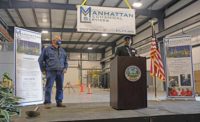The Latest in the Construction and Design Scene in Chicago and All of the Midwest

Old Chicago post office mixes modern office with historic structure
PHOTO BY JEFF YODERS/ENR

Booth Cottage, a historic Frank Lloyd Wright structure, moved
PHOTO COURTESY OF THE GLENCOE HISTORICAL SOCIETY AND MKA

SEAOI announces award winners
PHOTO COURTESY OF THE GLENCOE HISTORICAL SOCIETY AND MKA



Old Chicago Post Office Mixes Modern Office With Historic Structure
The $800-million makeover of the Old Chicago Post Office was completed late last year, but many of the offices in the reconfigured space haven’t had many tenants work in them yet because so many companies are having their employees work from home during the pandemic.
The 1921 structure was designed by Graham, Anderson, Probst & White. All 2.8 million sq ft of the art deco building is being transformed into offices, repurposed by architect Gensler, contractor BEAR Construction, developer 601W Cos. and interiors contractor Skender.
The Post Office is separated into three sections, the North, the East and the South buildings. The project team was also able to save the original clay tile floors.
“We did plaster and drywall all up on the ceiling and then the mechanical, electrical and plumbing of the space is run underneath,” says Lauren Torres, senior project manager and team leader at Skender. “It brings the ceiling-to-ceiling height a little bit lower.”
Navigating the requirements necessary to maintain the building's historic integrity while still delivering a space worthy of a modern, collaborative workplace resulted in solutions such as meeting spaces built inside the cavernous East building with “streets” on either side of them, along with streetlights and hanging patio lights on either side. A bar and entertainment space overlooks the Congress Parkway, giving its eventual patrons a view of the South Loop not often seen.
One of the other historic details that remains from the building’s former life is the mail vaults built into the building’s columns, which were kept as storage spaces for the new offices.
Booth Cottage, a Historic Frank Lloyd Wright Structure, Moved
On July 21, the Frank Lloyd Wright-designed Booth Cottage was moved from its original location to a public park in Glencoe, Ill., saving it from demolition and preserving it for use in historical research about Wright.
The cottage was originally built in 1913 at 200 Franklin Road in Glencoe for the family of Sherman Booth, Wright’s attorney, while their full-size home, another Wright-designed building, was constructed nearby. The cottage was donated to the Glencoe Historical Society after a new owner bought the property and the cottage was in danger of being razed.
In preparation for the move, the cottage was stripped of additions made over the past 60 years and returned to its original design. The historical society negotiated a long term lease with the Glencoe Park District to allow the cottage to be placed on the park, which is situated directly south of Ravine Bluffs, which includes additional Wright-designed homes and a bridge.
Vanessa Zoerb, co-president of the historical society, said, “The saving of this important transitional Wright design demonstrates to architectural and historical communities nationwide that Glencoe values the importance of the history of the built environment and is willing to go the extra mile to maintain that heritage.”
SEAOI Announces Award Winners
The Structural Engineers Association of Illinois announced its annual engineering awards at a virtual event held July 10 on the organization’s website.
The Structural Group won the Lavicka Award, annually given to a small firm or small project, for the AIRE Ancient Baths in Chicago.
The Ciorba Group received the best project award in the up to $10 million category for the Roselle Road Pedestrian Bridge in Chicago.
Cannon Design won the best project in the $10 million to $50 million category for a football athletic facility at the University of Maryland in College Park.
WSP received the best project award for 727 W. Madison in Chicago in the $50 to $150 million category.
Skidmore, Owings & Merrill won for the 100 Mount Street project in North Sydney, Australia, in the over $150 million category.
Thornton Tomasetti won the award for best renovation/restoration for the Willis Tower Repositioning in Chicago.
M. Baker International received the best bridge/transportation project award for the Winona Bridge in Winona, Minn.
The best new special structure award, a new category, went to Skidmore Owings & Merrill for the Dream Catcher sculpture in West Hollywood, Calif.
The jurors favorite/most innovative structure award went to engineer Magnusson Klemencic Associates for the Chase Center in San Francisco.
John Duntemann, senior principal at Wiss, Janney Elstner and Associates, won SEAOI’s service award. JJ Tobolski, an associate at Thornton Tomasetti, won the outstanding young engineer award, and Rose McClure, senior consulting engineer at Simpson Gumpertz & Heger, won the engagement award.










